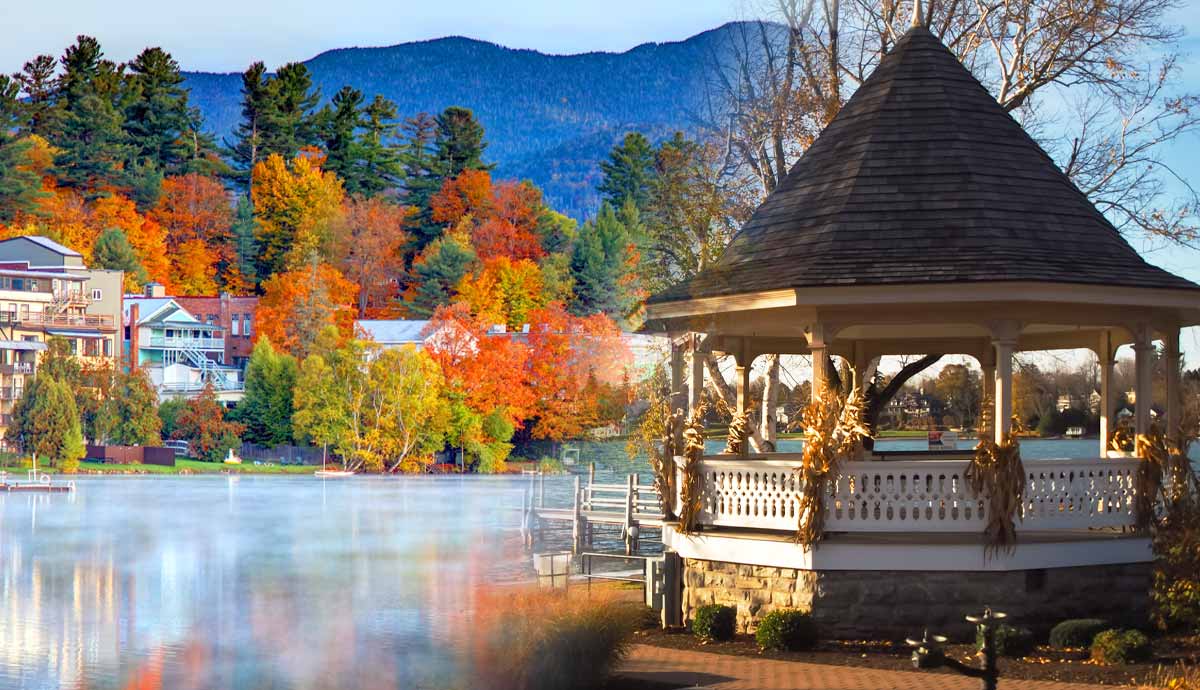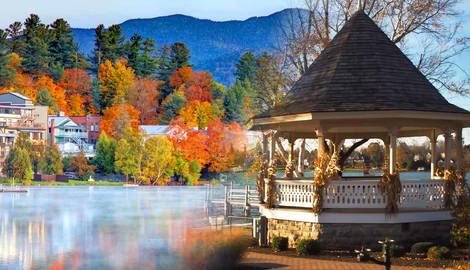
New York isn’t all about New York City and the Hamptons. It’s easy to overlook the Finger Lakes, the Adirondacks, the Catskills, and other gems that make the state so much more diverse than its urban centers. Upstate New York is an expansive region filled with natural beauty, from sprawling lakes and mountains to charming towns and farmland. Known for its wine trails, vibrant autumn foliage, outdoor recreation, and quaint villages, it’s also a haven for history lovers.
For those intrigued by tales of Revolutionary War battles, Gilded Age architecture, and the birthplace of movements that shaped the nation, Upstate New York’s small towns are where history truly comes alive. Here’s a look at ten historic towns in Upstate New York, each brimming with stories of the past and a sense of place you won’t soon forget.
1. Aurora

This historic village located on the eastern shore of Cayuga Lake was originally inhabited by the Cayuga people. The area was known as Chonodote, or “Peachtown,” due to its extensive orchards. In 1779, during the Revolutionary War, the village was destroyed by the Sullivan Expedition. This led to the dispersal of its indigenous inhabitants.
European-American settlement began in 1789, and by 1837, Aurora was incorporated as a village. It became a hub for canal traffic following the opening of the Cayuga-Seneca Canal, which facilitated the transport of wool, grain, fruit, and pigs to broader markets.
The Aurora Village-Wells College Historic District, listed on the National Register of Historic Places, is the first historic spot that you need to explore when visiting Aurora. This district showcases well-preserved 19th-century architecture. You also have the Aurora Inn, established in 1833. This one is a must-see as well. If you want to learn about the artistic heritage of this small town in Upstate New York, then head to the nearby MacKenzie-Childs Farm, which features handcrafted ceramics and home furnishings.
2. Cooperstown

Founded in 1786 by Judge William Cooper, this town that you will find at the southern tip of Otsego Lake was named in Cooper’s honor. His son, James Fenimore Cooper, a renowned novelist, immortalized the area in his “Leatherstocking Tales,” referring to Otsego Lake as the “Glimmerglass.”
Cooperstown is perhaps best known as the home of the National Baseball Hall of Fame and Museum, established in 1939. This institution celebrates the history of baseball and honors its greatest players, making the village a pilgrimage site for fans of America’s pastime.
Apart from baseball, Cooperstown also has plenty of attractions, which makes it one of the most beautiful historic towns in New York. The Farmers’ Museum provides a glimpse into 19th-century rural life and features historic buildings and demonstrations of traditional crafts. The Fenimore Art Museum houses an impressive collection of American folk art and Native American artifacts.
You can also visit Hyde Hall, a neoclassical mansion dating back to the early 19th century, to get an idea about the architectural heritage of this small town in Upstate New York.
3. Skaneateles

The name “Skaneateles” derives from the Iroquois term for “long lake,” which reflects the indigenous roots of this Upstate New York small town. European-American settlement began in the late 18th century, and the village was officially incorporated in 1833.
Skaneateles is nestled at the northern tip of Skaneateles Lake and is renowned for its well-preserved 19th-century architecture, with many buildings dating back to the 1830s. The downtown Historic District, established in 1985, showcases these architectural treasures. You can explore the Skaneateles Historical Society’s museum, housed in a former creamery building from 1899.
The village’s vibrant downtown features unique shops, restaurants, and historic inns, such as the Sherwood Inn, which has been welcoming guests since 1807. Skaneateles Lake, known for its clear waters, provides opportunities for boating, fishing, and lakeside relaxation.
Throughout the year, Skaneateles hosts various events, including the annual Dickens Christmas celebration, where the village transforms into a Victorian-era setting, complete with costumed characters and festive activities.
4. Seneca Falls

This Upstate New York town is often recognized as the birthplace of the women’s rights movement in America. In July 1848, it hosted the first Women’s Rights Convention at the Wesleyan Chapel, where activists like Elizabeth Cady Stanton and Lucretia Mott presented the Declaration of Sentiments, advocating for women’s equality.
You can visit the Women’s Rights National Historical Park, which includes the Wesleyan Chapel and the homes of key figures such as Elizabeth Cady Stanton. The National Women’s Hall of Fame recognizes the achievements of influential American women and their contributions to society.
Seneca Falls is also believed to have inspired the fictional town of Bedford Falls in Frank Capra’s classic film “It’s a Wonderful Life.” The town embraces this connection with an annual festival and the It’s a Wonderful Life Museum, which showcases memorabilia from the film.
Apart from its historical significance, Seneca Falls offers scenic beauty along the Seneca River and is part of the Finger Lakes region, which is known for its wineries and outdoor recreational opportunities.
5. Sackets Harbor

Sackets Harbor is particularly noted for its strategic importance during the War of 1812. Founded in 1801 by Augustus Sacket, the village’s deep natural harbor on Lake Ontario made it an ideal location for shipbuilding and military operations.
Sackets Harbor served as the headquarters for the U.S. Navy on the Great Lakes during the War of 1812 and was the site of two significant battles. The Sackets Harbor Battlefield State Historic Site preserves these historic grounds, which give you the chance to explore restored 19th-century buildings, exhibits, and interpretive trails that detail the military heritage of the village.
Sackets Harbor also boasts well-preserved 19th-century architecture, with tree-lined streets and historic homes that reflect its rich past. The village’s waterfront offers scenic views of Lake Ontario, making it a popular destination for boating, fishing, and leisurely strolls along the harbor.
Cultural attractions include the Sackets Harbor Historical Society, which provides you with a glimpse into the area’s history through exhibits and events. The village also hosts annual festivals and concerts to celebrate its heritage and community spirit.
6. Lake Placid

Established in the early 19th century, Lake Placid, part of New York’s charming Adirondack Mountains, gained prominence as a resort destination because it attracted visitors to its pristine lakes and mountainous landscapes.
The village’s global recognition stems from hosting the Winter Olympics twice. The first time was in 1932, and the second in 1980. The 1980 Games are particularly memorable for the “Miracle on Ice,” where the U.S. hockey team triumphed over the favored Soviet Union.
Start your visit by exploring the Lake Placid Olympic Museum, where you’ll see artifacts and exhibits from both Olympic events. The Olympic Center, featuring the historic Herb Brooks Arena, offers information about the sporting legacy of Lake Placid.
Apart from its Olympic heritage, Lake Placid offers year-round recreational activities. Whiteface Mountain provides skiing and snowboarding in winter, and hiking and mountain biking during warmer months. Mirror Lake is located in the heart of the village. It is ideal for kayaking, paddleboarding, and ice skating.
The village’s Main Street is lined with shops, restaurants, and historic inns, reflecting its charming character. Nearby, the John Brown Farm State Historic Site commemorates the abolitionist’s life and legacy.
7. Chatham

Established in the early 19th century, Chatham was originally known as Groat’s Corners, named after early settler Captain Thomas Groat. The Upstate New York village became a significant railroad hub in the mid-1800s, with multiple rail lines converging here. This brought to town massive economic growth and development.
When you visit Chatham, start by exploring its well-preserved 19th-century architecture, including the Tracy Memorial Village Hall, built in 1912, and the historic Union Station, constructed in 1887.
Also, the Main Street of Chatham is interesting to explore as it’s lined with unique shops, restaurants, and the Crandell Theatre, one of the oldest continuously operating movie theaters in the region.
Chatham hosts several annual events that celebrate its heritage and community spirit, such as the Columbia County Fair, which has been a local tradition since the mid-19th century. As for the Chatham Village Historical Society, it offers walking tours and maintains exhibits that teach you about the village’s past.
8. Ticonderoga

Strategically situated between Lake George and Lake Champlain, Ticonderoga’s name derives from the Mohawk word “tekontaró:ken,” meaning “it is at the junction of two waterways.”
The town is renowned for Fort Ticonderoga, originally constructed by the French in the 1750s as Fort Carillon. This fortification played pivotal roles in both the French and Indian War and the American Revolutionary War. In 1775, Ethan Allen and Benedict Arnold led a surprise attack, capturing the fort from the British, marking the first American victory of the Revolutionary War.
You can explore the meticulously restored Fort Ticonderoga, which offers interactive exhibits, reenactments, and stunning views of the surrounding lakes. The town also boasts a rich industrial heritage, notably in graphite mining. The iconic Dixon Ticonderoga pencil was named after the graphite mined and processed in the area.
The Ticonderoga Heritage Museum showcases the industrial past of this Upstate New York small town, including its contributions to the paper and pencil industries. Additionally, the La Chute River Trail offers a scenic walk along the river that connects Lake George to Lake Champlain.
9. Hammondsport

Found at the Keuka Lake’s southern tip, one of the Finger Lakes, Hammondsport has been a hub for winemaking since the 19th century. In 1829, Reverend William Bostwick planted the first grapevine in the area. This led to the establishment of a thriving wine industry.
The village is also notable as the hometown of aviation pioneer Glenn H. Curtiss. Known as the “Father of Naval Aviation,” Curtiss made significant contributions to early aviation and motorcycle design. The Glenn H. Curtiss Museum in Hammondsport showcases his achievements and features exhibits on early aviation, motorcycles, and local history.
Head to the Pleasant Valley Wine Company, established in 1860 and designated as U.S. Bonded Winery No. 1. The winery offers tours and tastings. This allows you to learn about Hammondsport’s winemaking heritage.
The picturesque setting of the town on Keuka Lake offers opportunities for boating, fishing, and lakeside relaxation. Also, the village’s historic downtown features charming shops, restaurants, and inns, reflecting its rich heritage and welcoming atmosphere.
10. Ballston Spa

Located southwest of Saratoga Springs, Ballston Spa was established in 1807. The village was named after Rev. Eliphalet Ball, an early settler. In the early 19th century, Ballston Spa gained prominence as a premier destination for its mineral springs. Visitors were flocking there seeking therapeutic benefits. The village was also home to the Sans Souci Hotel, built in 1803, which was the largest hotel in the United States at that time.
The first historic place you need to explore is the Brookside Museum, housed in a 1792 building that once served as a resort hotel. The museum offers exhibits on local history and is one of the oldest structures in the village. The National Bottle Museum showcases the history of bottle-making and its significance to the area.
Ballston Spa’s downtown area features well-preserved 19th-century architecture, with unique shops, restaurants, and historic inns. Wiswall Park, located in the heart of the village, hosts community events and concerts that allow you to learn about the vibrant community spirit there.










